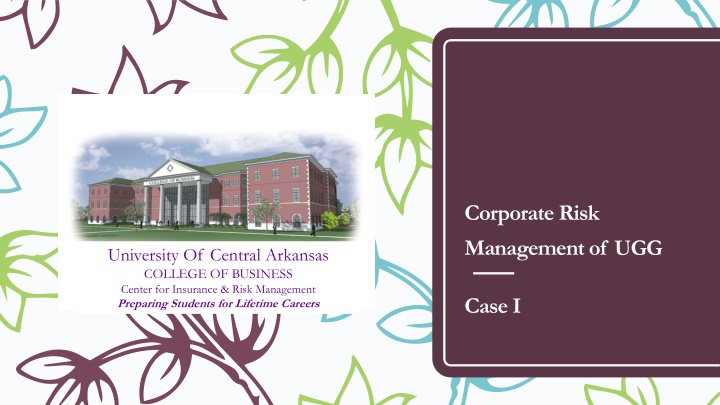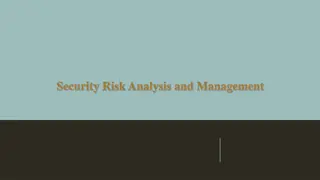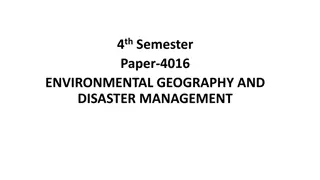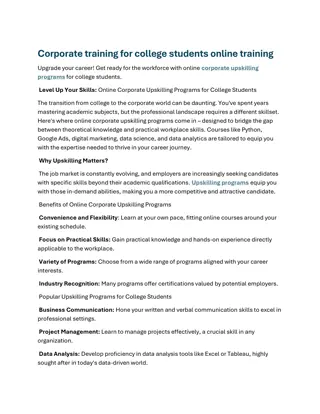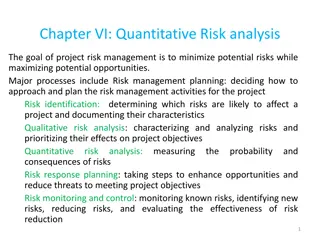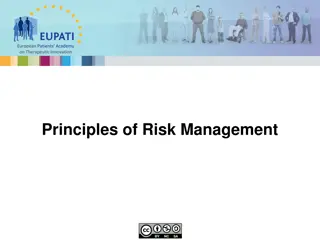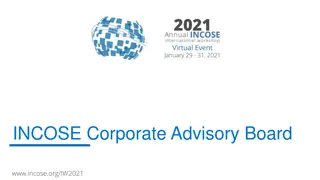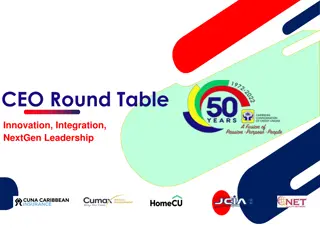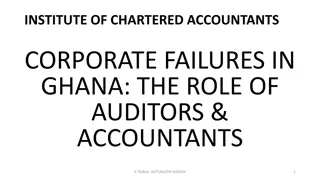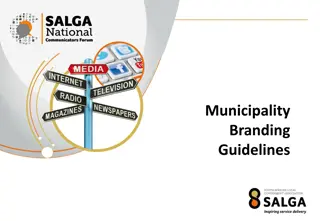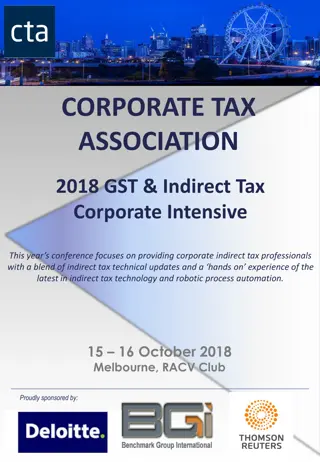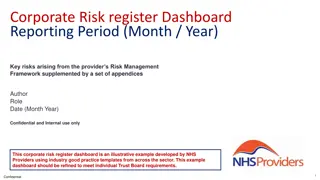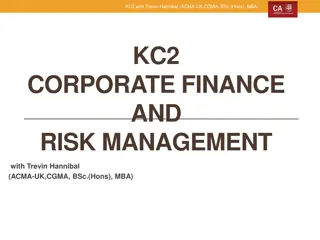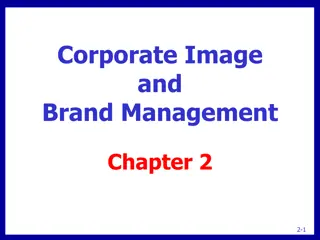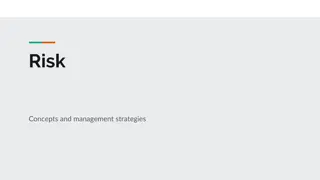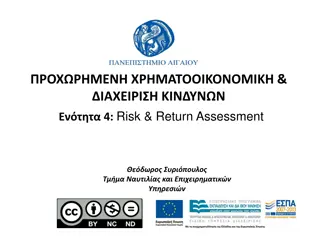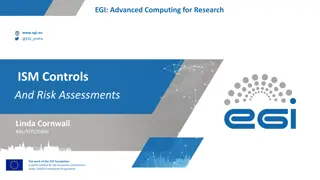Corporate Risk Management at UGG: Case Study
This case study focuses on United Grain Growers (UGG) and their enterprise risk management program. Founded in 1906, UGG adopted an ERM approach in the late 1990s, with a primary focus on managing risks like weather and market fluctuations across their business segments. Learn how UGG identified and assessed key risks to protect their cash flows and value.
Download Presentation

Please find below an Image/Link to download the presentation.
The content on the website is provided AS IS for your information and personal use only. It may not be sold, licensed, or shared on other websites without obtaining consent from the author.If you encounter any issues during the download, it is possible that the publisher has removed the file from their server.
You are allowed to download the files provided on this website for personal or commercial use, subject to the condition that they are used lawfully. All files are the property of their respective owners.
The content on the website is provided AS IS for your information and personal use only. It may not be sold, licensed, or shared on other websites without obtaining consent from the author.
E N D
Presentation Transcript
Corporate Risk Management of UGG University Of Central Arkansas COLLEGE OF BUSINESS Center for Insurance & Risk Management Preparing Students for Lifetime Careers Case I
Learning Objective This is a case study designed to illustrate risk management process. 2
United Grain Growers (UGG) Background The case is deliberately set in a realistic business setting to help you understand the steps of enterprise risk management. UGG was founded in 1906 as a farmer-owned cooperative, and became a publicly traded company on the Toronto in 1993---some members are shareholders UGG is one of the first non-financial institutions to implement an Enterprise Risk Management programme. It adopted an ERM approach in the late 1990s.
United Grain Growers (UGG) Background UGG is comprised of four main business segments: Grain Handling Services, Crop Production Services, Livestock Services, and Business Communications. The two largest lines of business, Grain Handling Services and Crop Production Services, account for over 80 percent of UGG s earnings in most years. The firm s largest source of revenue was from grain handling, that is, shipping and storing grain produced by farmers. The company provided inputs and services to farmers in western Canada. The inputs and services included almost everything that a farmer would need to produce crops and livestock, including seed, fertilizer, and feed. UGG s smallest business unit is Farm Business Communications The percentage of the firm s total assets financed with debt increased to about 37 percent with the issuance of another 50 million Canadian dollars in long-term debt.
Enterprise Risk Management Traditional risk management refers to the management of pure risks, e.g., losses from property damage, liability suits, and worker injuries. These risks typically are managed through a combination of loss control (efforts to reduce the likelihood or magnitude of losses) and loss financing through internal retentions or the purchase of insurance. Financial risk management typically refers to the management of price risks Enterprise risk management (ERM)--Firm should examine all of its risk exposures and deal with them using a consistent framework
UGG Major Risks UGG employed the Willis Group to help them implement an ERM process. A large number of risks were identified and preliminarily assessed. The list was narrowed to six. The actuaries and statisticians at Willis then worked on assessing these risks in terms of their potential impact on the firm s cash flows and value. They found that the most important risk facing UGG was weather.
UGG CasePart I The first part of the case study allows us to consider fundamental issues of risk management: Why does it make sense for a firm to manage its risks? From where do these risks arise? How do firms measure and analyze risks?
Question 1a: Like most firms, UGG faces a variety of risks. How will you categorize the risk in Table 4? Hint: You can make a table and categorize risks based on four quadrant risks as shown below. The four quadrant risks are widely used in Enterprise Risk Management. You can add more risk categories as other options if you like.
Question 1b: Please list three risks of the six major risks in Table 5 to answer the question. What elements of the business (such as revenue, operating costs, investment needs, working capital, ability to raise financing) might be affected by each risk? Hint: You can consider multiple elements of the business, such as revenue, operating costs, extraordinary costs, working capital, need for investment and cost and availability of financing. Please list the influences of three major risks. For example, adverse weather will reduce grain volumes. In the grain handling business, volumes translate directly into revenues. Adverse weather might make farmers less able to meet their commitments to UGG in a timely manner. Accounts payable and thus working capital may increase. Adverse weather may affect spoilage or other losses. With a decrease in revenues and receivable, UGG s primary source of financing is reduced.
Question 2: How can UGG manage its risks in your opinion for each of the six major risks in Table 5? Hints: You can use different risk control techniques and risk financing techniques from Chapter 3 page 51 to 53 to answer the question. For example, environmental risk was generally controlled using property and liability insurance and well defined and executed operating procedures to reduce loss frequency and severity.
Question 3: Considering weather risk as one of the most significant risks for UGG, and acknowledging that any approach to mitigate this risk will incur costs, what potential benefits can UGG's diversified owners expect from reducing the weather risk? Hint: There are at least three reasons why reducing risk might benefit UGG s diversified shareholders. You can consider cash flow volatility, internal capital and external capital availability, financial distress and capital cost such as borrowing funds. You can also consider risk management goals and benefits such as tolerable uncertainty, survival, business continuity, earnings stability, profitability and growth, social responsible, etc. For example, considering earnings stability, profitability and growth, managing weather risk can reduce the volatility in its cash flows due to variability in grain volume. Please give detail explanations in your analysis.
Question 4: Should UGGs rather unique ownership structure influence the decision to reduce the weather risk exposure? Hint: This question asks you to think about how the ownership and governance structure of a corporation can influence risk management. UGG has members and shareholders. Farmers who do business with UGG can become members. Think about the way ownership structure would changes UGG s risk tolerance and attitude toward firm s profit and earning stability, etc. Would farmers prefer more risks comparing to shareholders in other listed firms?
UGG CasePart II The next step was to determine what to do about the weather risk. This is where the innovative thinking and the convergence of finance, insurance, and risk management is most evident.
Managing Weather Risk UGG actively manages five of its top six risks by using a variety of means, but the largest risks weather was not managed at all. They knew that the primary reason weather was important was because weather affected UGG s grain shipments. Retention vs Weather Derivatives vs Commercial Insurance
Weather Derivatives A contract could be tailored on a number of dimensions to meet the specific needs of the buyer: average temperature, rainfall, snowfall or heat index, etc. As the index increases, expected gross profit increases (as crops yields increase, which in turn increases UGG s shipments of grains and seeds) as in Part A (next slide) Low values of the weather index correspond to low expected profits for UGG, a derivative contract that would pay UGG money when the index is low would provide a hedge as in Part B. When the put option payoff from Part B is added to expected gross profit from Part A,UGG s expected gross profit would vary with the weather index as in Part C.
Insurance Contract The obvious problem with such an insurance contract is moral hazard UGG s pricing and service also influences its grain shipments. One solution to this problem was to use industry-wide grain shipments as the variable that would trigger payments to UGG. Industry shipments would likely be highly correlated with UGG s shipments. Because of its relatively low market share, UGG would have minimal effect on the value of industry-wide shipments, which would significantly reduce the moral hazard problem. Efficient and effective of the insurance contract: an insurer may integrate grain volume coverage with UGG s other insurance coverage (bundling UGG s traditional property and liability insurance)
Question 5a: Regarding the insurance contract option, if UGG manages to find an insurer willing to cover weather risk, do you believe the insurer would be more inclined to offer a contract that pays UGG if the firm's grain handling division profits fall below a certain threshold or a contract that compensates them if overall Canadian grain volumes drop below a specific level? Why? Hint: moral hazard issue in the previous PPT 5b: Assuming all other factors are equal, would UGG prefer to underwrite an insurance contract based on the risk of rainfall or grain volumes? Why? Hint: All other things being equal, would UGG rather write a contract on rainfall or grain volumes? Hint: Which way can produce a better predicted value of losses for UGG?
Question 6: What are the advantages and disadvantages of integrating the grain volume coverage with the firm s other insurance coverages? In other word, what are the pros and cons of bundling all of the firm's exposures into a single policy with a unified deductible and limit, rather than having separate policies with individual deductibles and limits for each exposure, including the grain volume exposure? Hint Please consider: a. the aggregate loss is important; b. diversification of risk less variability; c. lower deductible high premium vs. high deductible and low insurance premium; d. economizing information gathering and administration expenses
Cost of risks=insurance premium + expected retained loss 1,202,500 1,280,000 1,200,000 Cost of risks You can see from the simple example that low deductible with high insurance premium may be even worse than no coverage and bundled policy. The disadvantage of bundled policy is relatively small losses are not covered.
Question 7a: Disregarding cost differences, what are the advantages and disadvantage of using an insurance contract compared to employing weather derivatives? Hint: Please provide your perspective on basis risk and moral hazard. The basis risk is the inherent risk 7(b): If you are a member of the UGG risk team, which option would you prefer: an insurance contract or weather derivatives? Hint: Please provide your opinion about the insurance contract vs. weather derivatives.
Question 8a: What are other loss control measures that could be used to manage UGGs weather risk? Hint: based on the firm s background, please list other loss control measures and give explanations. 8(b) How would each loss control measures finance the capital expenditures, either internally, externally or both? How would it impact cash flow and funds?
